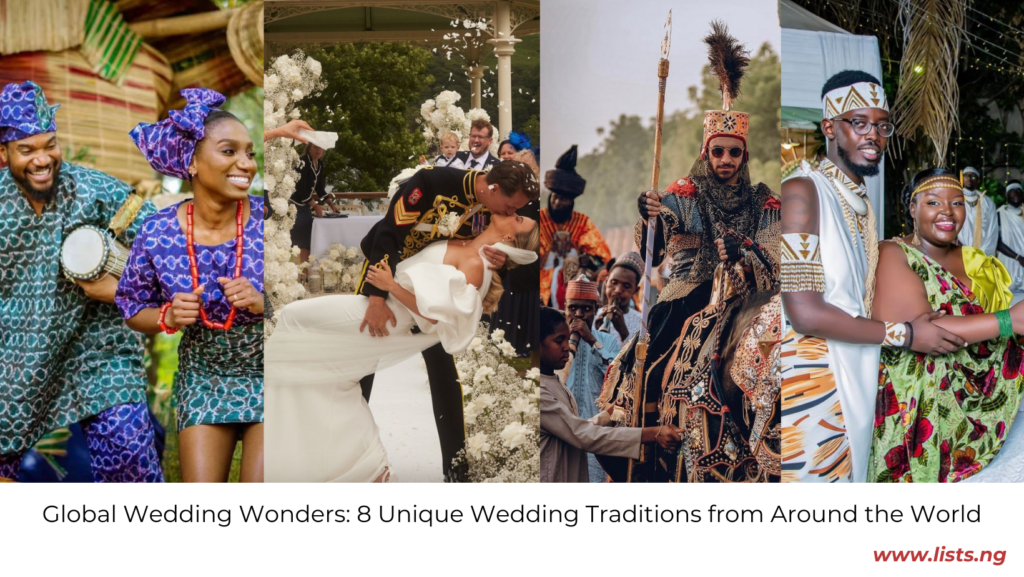Weddings are a universal celebration of love, but the ways in which different cultures celebrate this union can be wonderfully diverse and unique. Each tradition offers a unique glimpse into the values, beliefs, and histories of the communities that uphold them.
Here are a few fascinating wedding traditions from around the world:
- The Indian Baraat
The Baraat is a crucial part of Indian weddings, especially in North Indian cultures. It symbolizes the groom’s readiness to marry and take responsibility for his bride. One of the most vibrant and energetic wedding traditions that comes from India is the Baraat. This grand procession, filled with music, dancing, and celebration, marks the groom’s journey to the wedding venue and is a spectacle that embodies the joy and festivity of an Indian wedding.
The groom traditionally rides a beautifully decorated white horse, though in modern times, some opt for more elaborate choices like elephants, carriages, or even luxury cars. The groom, dressed in elaborate attire, often including a sherwani (a long coat-like garment), a safa (turban), and sometimes a sehra (a veil of flowers or beads), leads the Baraat. The horse, adorned with colorful decorations, is a sight to behold, adding to the grandeur of the procession. The Baraat is more than just a grand entrance; it is a display of cultural richness and community spirit. It reflects the joyous nature of Indian weddings.
- The Greek Money Dance
A fascinating tradition is the Greek Money Dance, it is a lively and symbolic ritual that embodies the joy and prosperity wished upon the newlyweds. It’s a vibrant, joyful, and meaningful practice that encapsulates the essence of marriage: love, support, and community. Whether you’re attending a Greek wedding or considering incorporating this tradition into your own, the Money Dance is sure to create unforgettable memories and bring everyone closer together. For Greek couples, incorporating the Money Dance into their wedding is a way to honor their heritage and keep ancient traditions alive. For those from other cultures, it can be a delightful addition that brings a touch of Greek charm and a sense of global unity to their celebration.
- The Igbo Wedding Tradition
The Igbo wedding tradition is a beautiful and meaningful ceremony that highlights the rich cultural heritage of the Igbo people. It is a celebration of love, mutual respect, and communal joy, offering a profound glimpse into the values that underpin Igbo society. The highlight of the ceremony is the wine-carrying ritual. The bride is given a cup of palm wine by her father, which she is to offer to her chosen groom. As she takes the cup, she dances through the crowd, searching for her groom among the guests. This journey is often playful, as guests might tease her or try to misdirect her. When the bride finds her groom, she kneels before him and offers him the cup of palm wine. The groom accepts the cup, takes a sip, and then drinks the rest, signifying his acceptance of the bride and their union. This act is met with cheers and applause from the guests, symbolizing the community’s approval and blessings for the couple.
After the wine-carrying ritual, elders from both families offer prayers and blessings for the couple. These prayers are deeply rooted in Igbo spirituality and cultural beliefs, invoking divine favor, protection, and prosperity for the newlyweds. The elders’ blessings are considered essential for the couple’s future happiness and success.
- Maasai Wedding Ceremony
Among the Maasai of East Africa, a traditional wedding is not just a union of two individuals but a vibrant celebration that involves the entire community. Rich with symbolism and deeply rooted in ancestral customs, Maasai wedding traditions are a fascinating glimpse into a culture that honors its past while celebrating the future. The Maasai wedding ceremony itself is a colorful and lively event. It usually begins with the bride leaving her father’s home, often accompanied by singing and dancing. As she makes her way to the groom’s village, she is escorted by her family and friends, who bless her and wish her well. Upon arrival, the bride and groom participate in various rituals, including blessings from elders and symbolic gestures that represent their new life together. One such ritual involves the groom spitting on the bride’s head and breasts, a Maasai blessing that signifies good fortune and fertility.
Every element of a Maasai wedding is rich with symbolism. The bride price represents the value and respect accorded to the bride. The beadwork and jewelry worn by the bride highlight her beauty and status. The shaving of the bride’s head signifies a fresh start, and the communal celebrations underscore the importance of unity and collective joy.
- The Yoruba Wedding Engagement Ceremony
Africa is a continent rich in cultural diversity, with each community offering unique traditions that celebrate the union of love and family. One such remarkable tradition is the Yoruba wedding engagement ceremony. The event typically takes place at the bride’s family home or a designated venue adorned with colorful decorations, reflecting the joyous nature of the occasion. Traditional Yoruba attire is worn, with the bride and groom donning richly embroidered fabrics, known as “aso oke,” along with matching accessories that signify their cultural heritage. The ceremony starts with the arrival of the groom’s family, who come bearing gifts, known as “Eru Iyawo,” for the bride’s family. These gifts often include kola nuts, alligator pepper, bitter kola, honey, and other symbolic items that signify goodwill and blessings. The groom, accompanied by his family members, kneels before the bride’s family to show respect and formally request their daughter’s hand in marriage.
The Yoruba engagement ceremony is rich with symbolism. The act of kneeling, the exchange of gifts, and the communal prayers all signify respect, commitment, and the importance of family in Yoruba society. This tradition emphasizes that marriage is not just a union of two individuals but a coming together of two families and communities.
- The French La Mairie Wedding Ceremony
In France, one of the most charming and significant traditions is the civil wedding ceremony at the town hall, known as “La Mairie.” This tradition, rooted in French legal and cultural practices, offers a blend of formality, community, and romance that is quintessentially French.
La Mairie is the mandatory civil ceremony required for all couples wishing to marry in France. Regardless of any religious ceremonies that might follow, a wedding is not legally recognized in France without this official event.
- The Paebaek Ceremony
The Paebaek ceremony dates back to ancient Korea and has been a cherished tradition for centuries. Originally, it was a private event held in the groom’s home, where the bride would formally meet and bow to her new in-laws. Over time, this ceremony has evolved but continues to be an integral part of Korean wedding celebrations. The highlight of the Paebaek ceremony is the ritual of tossing chestnuts and dates. In this symbolic act, the parents throw chestnuts (representing sons) and dates (representing daughters) into the bride’s skirt or a cloth held between the couple. The number of chestnuts and dates caught is believed to predict the number of children the couple will have. This playful and meaningful tradition adds an element of fun while symbolizing fertility and the continuation of the family.
The Paebaek ceremony emphasizes the importance of family in Korean culture. It is a moment for the couple to show their respect and gratitude to their parents and receive their blessings in return. This exchange strengthens the bond between the families and marks the beginning of a new chapter in their collective lives.
- The Hausas Wedding Ceremony
In Northern Nigeria, the Hausa community celebrates marriage with a series of rich and unique traditions. Among these, the Kamu ceremony stands out as a particularly intriguing and festive pre-wedding event.
Kamu, which means “catch” in Hausa, is a traditional ceremony where the bride is symbolically hidden by her friends and female relatives, and the groom’s family must “find” and “negotiate” for her release. The Kamu ceremony is rich in symbolism. The hiding of the bride represents her value and the protective role of her family. The negotiation and eventual “release” of the bride signify the groom’s respect for her family and his readiness to support and cherish her. This ritual also highlights the importance of family involvement and communal support in Hausa weddings.
Wrapping Up,
Love transcends boundaries, with each culture bringing unique wedding traditions that connect the past to the present. From India’s vibrant dances to the Yoruba’s engagement wedding ceremonies, these customs highlight the universal joy of uniting two lives.
Here’s to embracing and appreciating the myriad ways we honor this timeless union.



